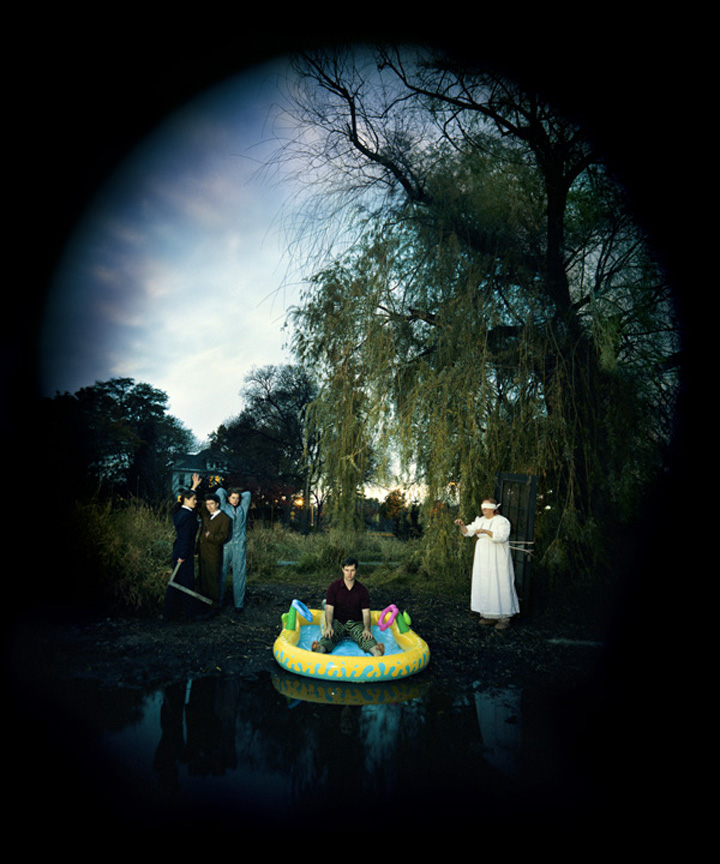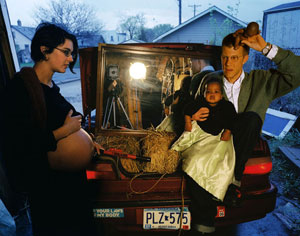Decoding: Dreams and Allegories
Camille LeFevre attended the opening of Sean Smudas recent show at Flanders Gallery (through April 28) of his complex tableaux photographs. She enjoyed the pursuit of elusive meaning they offer.



During the opening of Sean Smuda’s “Dreams and Allegories” last Saturday at Flanders Gallery, a small crowd gathered in front of “Immaculate Conception,” one of a series of 13 staged, photographed tableaux reproduced as laser prints. We were all actively, and soon collectively, engaged in an attempt to accurately “read” the art, using the signs (the pro-choice bumper sticker, the license-plate letters PLZ as “please”) and symbols (the woman’s pregnant belly, “The Club” for securing a car, the hay in the car trunk, the doll) as interpretive cues.
In other words, as semiotic art historian Mieke Bal has written, “the outcome is meaning, that it functions by way of discrete visible elements called signs to which meanings are attributed; that such attributions of meaning, or interpretations, are regulated by rules, named codes; and that the subject or agent of this attribution, the reader or viewer, is a decisive element in the process.” It’s a process underscored by Smuda’s inclusion, in almost every photograph, of a character who beckons one to participate by looking directly at the photographer/viewer. In the case of “Immaculate Conception” it’s perhaps the toddler, or the god-like photographer himself as reflected in the mirror behind the camera and next to a blast of light.
Our collaborative decoding led us to interpret “Immaculate Conception” as a postmodern manger scene with the pregnant Mary, her belly unprotected except for The Club she grasped for her potential defense, as a calm yet serious representation of a woman’s right to choose. She stands utterly disconnected from Joseph, represented by an angry or frustrated stereotypical white male in suit (i.e., the ones who govern the patriarchal culture that oppresses women, and anyone else not included in its own category).
“But why is he holding a baby to his head?” one woman demanded. “Another form of immaculate conception,” I ventured, “like Venus springing from the head of Zeus? Or maybe it represents rational thought and the need to control things using the mind, not the heart?” She seemed satisfied, but then asked, “But why are the children black?” That question none of us could answer, but we knew Smuda was commenting somehow on race. We looked for a while longer, then dispersed. There were other images in need of study.
Whew, someone might say. That’s a lot of work for one picture. True, but the work is also part of the fun. Although I doubt Smuda intends these pictures—laden with irony, dispassionate seriousness, and nonchalance, with the occasional outburst of exuberance—to be “fun.” He intends us to work, to engage, to participate. Chris Schlicting, a local dancer who posed for “Initiation,” said during the opening that Smuda’s pictures are like puzzles, with the imagery being the jagged pieces in need of assembly to find meaning. We are then, the “decisive element in the process.”
Many of Bal’s codes—let’s call them Smuda’s themes—become clear during the cumulative effect of looking at other tableaux in the series, each of which is an individual narrative in search of viewer engagement. (“Immaculate Conception” is hung on a south wall at a midpoint in the two-room exhibition.) Chief among Smuda’s themes are religion (Christian, particularly Catholic, but with a smattering of paganism in “Tree of Life”); politics (anti-war and pro-choice); and science and rational thought (note the equation-like t-shirt in “Conspiracy” and blackboard equations in “Faith,” and what looks like an engineering textbook connected to a power cord in “Oasis”).
He also appropriates and recasts the iconic imagery and methodologies of art history in his tableaux. In “Moment of the Day,” a model of indeterminate gender reclines like Manet’s “Olympia” on a gold couch, holding the viewers’ gaze (the baby looks at us, too) as the two men in the picture stand with eyes closed. All are oblivious to the gun ominously pointing at them just inside the frame. Aside: Similarly, in “Faith,” a disembodied hand enters the frame and points a finger at the people gathered on the lawn with punitive, godlike omniscience.
Smuda’s visually layered pictures often have the high gloss, chiaroscuro, and object clutter of an Old Masters’ still life, except rendered via a post-modern grunge aesthetic. The collage-like juxtaposition of everyday objects in such pictures as “Initiation,” “Faith,” and “Oasis” is also Dadaist in impulse, although Smuda intends us to find sense within his nonsensical juxtapositions. In “The Scrape,” for example, the nonsensical script written on the white board, the players caught in the midst of the event described, and the appropriation of such costuming as the dunce caps (which also come with Ku Klux Klan connotations) has a Dada sense of humor/horror without Dada’s deliberate discontinuity between elements.
Surrealism is also evident in Smuda’s work. He appropriates such classic iconography as a key emerging from a mouth that’s meant to unlock secrets (in the case of Seeding,” the handcuffs linking two women gazing in opposite directions). (Filmmaker and dancer Maya Deren incorporated the key-in-the-mouth imagery beautifully in her surrealist masterpiece, the film “Meshes of the Afternoon”). The blindfolded woman in white, roped to a door perched precariously over water in “Possession of One’s Proper Body,” brings together a cavalcade of symbolic connotations that intensify the surrealistic feel of the picture overall.
Finally, a word about “Seeding,” which combines a Dada-style juxtaposition of people representing various occupations, a sense of gathering that reminds one of a 1960s Happening, and an earthy peace-and-loveness in the stark contrast between dirt and lush grass and foliage. Here Smuda’s also saying something about minimalism, the pinnacle of spiritualism and cleanliness in art, as a man in white apron, chef jacket, and gloves casually holds a white cube in one hand, and is ready to push a vacuum cleaner with the other.
Another artist who stages his photographic images has lately been dominant in the New York art news, the Vancouver-based photographer Jeff Wall. Magazine and newspaper images of his large-scale pictures show significantly less-crowded tableaux than in Smuda’s work; a similar sense of alienation; art-historical references; and a movie director’s sense of drama. But Wall’s work also has a greater sense of beauty, almost sublimity. It’s an invitation to witness a seemingly random moment.
Smuda’s tableaux, however, are dense, crowded, extravagantly staged narratives that, at first glance, might not seem worth the trouble. We pass by them, visually gloss over them, leaving them to someone else. Meanwhile, something in another picture snags us. It might be that pregnant belly and bumper sticker, or Karen Sherman’s stance and shiny blue suit (“The Invention of Photography”) or Morgan Thorson, Arwen Wilder, and Kristin Van Loon huddled together (“Possession of One’s Proper Body”).
Those women, of course, as well as Schlicting, are members of the Minneapolis downtown or post-postmodern dance movement. That Smuda uses them as personnel in his work, has taken them from the concert stage and arrested their physical kineticism in elaborately staged, photographed tableaux, brings yet another subtext to “Dreams and Allegories:” that of time and the body, and their selective representative in the photographic image.